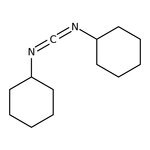Search Thermo Fisher Scientific
N,N’-Dicyclohexylcarbodiimide, 99 %, Thermo Scientific Chemicals



N,N’-Dicyclohexylcarbodiimide, 99 %, Thermo Scientific Chemicals
Identifiants chimiques
Spécifications
Description
This Thermo Scientific Chemicals brand product was originally part of the Alfa Aesar product portfolio. Some documentation and label information may refer to the legacy brand. The original Alfa Aesar product / item code or SKU reference has not changed as a part of the brand transition to Thermo Scientific Chemicals.
Le N,N′-Diccyclohexylcarbodiimide est un réactif d’activation carboxylique utilisé dans la synthèse des peptides. Il agit comme agent déshydratant pour la préparation d’amides, de cétones et de nitriles. Il est impliqué dans la préparation des esters en faisant réagir les alcools tertiaires avec de l’acide carboxylique. Il est utilisé pour l’inversion chimique stéréophonique des alcools secondaires en formant un ester formyle suivi de la saponification. Il est associé au diméthylsulfoxyde et utilisé dans l’oxydation de Pfitzner-Moffatt pour convertir les alcools en aldéhydes et cétones.
Solubilité
Soluble dans le méthanol, le chloroforme, le dichlorométhane, l’acétonitrile, le tétrahydrofurane et le diméthylformamide. Insoluble dans l’eau.
Remarques
Incompatible avec les agents oxydants forts.
Figures
Documentation et téléchargements
Certificats
Foire aux questions (FAQ)
Citations et références
Sécurité et manipulation
Classification of the substance or mixture
CLP classification - Regulation(EC) No 1272/2008
Label Elements
Signal Word
Danger
Hazard Statements
H302 - Harmful if swallowed
H311 - Toxic in contact with skin
H317 - May cause an allergic skin reaction
H318 - Causes serious eye damage
H410 - Very toxic to aquatic life with long lasting effects
Precautionary Statements
P280 - Wear protective gloves/protective clothing/eye protection/face protection
P301 + P330 + P331 - IF SWALLOWED: rinse mouth. Do NOT induce vomiting
P302 + P352 - IF ON SKIN: Wash with plenty of soap and water
P305 + P351 + P338 - IF IN EYES: Rinse cautiously with water for several minutes. Remove contact lenses, if present and easy to do. Continue rinsing
P310 - Immediately call a POISON CENTER or doctor/physician